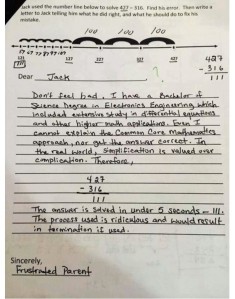You have seen this on Facebook.
- My annotated version (Click to enlarge)
Ugh what a mess.
Please share the annotated version widely.
I’ll say what I have to say (comments closed) and move on. If you wish to discuss further, hit me up on Twitter or pingback to the blog. Want to talk in private? Click the About/Contact link up top.
Also, Justin Aion—middle school teacher extraordinaire—wrote up his views on the matter. You can read them over in his house.
Here goes…
The intended answer
Dear Jack,
You only subtracted 306 from 427, not 316. You need to subtract another 10 to get the correct answer of 111.
Sincerely,
Helpful student
The purpose of this task
I cannot say whether this was the right task for this child at this time because I do not know the child, the teacher or the classroom.
I can say the following:
- Analyzing errors is a useful way to encourage metacognition, which means thinking about your thinking. This is an important part of training our minds.
- The number line here is a representation of a certain kind of thinking—counting back. The number line is not the algorithm. The number line records Jack’s thinking. He counted back from 427 by hundreds. Then he counted back by ones. He skipped the tens. We can see this error because he recorded his thinking with a number line.
- Coincidentally, the calculation in question requires no regrouping (borrowing) in the standard algorithm, so the problem appears deceptively simple in its simplified version.
- This task is intended to help students connect the steps of the standard (simplified) algorithm with reasoning that is based on the values of the numbers involved. Why count back by three big jumps? Because you are subtracting 300-something. Why count back by six small jumps? Because you are subtracting something-something-6. Wait! What happened to the 1 in the tens place? Oops. Jack forgot it. That’s his mistake.
So what?
The Common Core State Standards do require students to use number lines more than is common practice in many present elementary curricula. When well executed, these number lines provide support for kids to express their mental math strategies.
No one is advocating that children need to draw a number line to compute multi-digit subtraction problems that they can quickly execute in other ways.
But the “Frustrated Parent” who signed that letter, and the many people with whom that letter resonated, seem not to understand that they themselves think the way Jack is trying to in this task.
Here is the test of that.
A task
What is 1001 minus 2?
You had better not be getting out paper and pencil for this. As an adult “with extensive study in differential equations,” you had better be able to do it as quickly as my 9-year old.
He knows with certainty that 1001 minus 2 is 999. But he does not know how to get the algorithm to make that happen.
If I have to choose one of those two—(1) Know the correct answer with certainty based on the values of the numbers involved, and (2) Get the correct answer using a particular algorithm, but needing paper and pencil to solve this and similar problems—I choose (1) every time.
But we don’t have to choose. We need to work on both.
That’s not Common Core.
That’s common sense.
[Comments closed]







Pingback: Facebook, Math, and The Common Core | MathyCathy's Blog – Mrs. Cathy Yenca
Pingback: When Subtraction Problems Aren’t Really About Subtraction | mathcoachblog
Pingback: Common Core | Five Twelve Thirteen
Pingback: Traditional Algorithms SUCK!!!
Pingback: Grounded Parents | Knowing vs Teaching
Pingback: Knowing vs Teaching | Lance's Blog
Pingback: louie | sonata mathematique